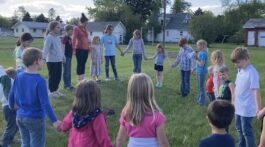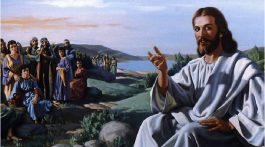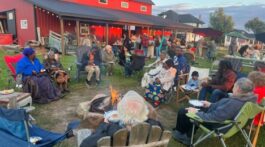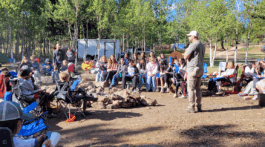Sabbath School Lesson for March 3-9, 2018
Stewardship has been viewed from many angles during our study this quarter. We’ve broken it down into manageable pieces, showing its important features. But this week we step back and see where it fits into the whole picture of our Christian experience.
The analogy of a wheel fits our need to see stewardship for what it is. Without it, our road in life is bumpy indeed. The expression of being “where the rubber meets the road” comes to mind here. In other words, when we see stewardship as the part of the wheel that touches the road, we will see that it must be a vital and visible part of our Christianity.
And it’s exactly that: “where the rubber meets the road”. Where God’s imparted divinity touches the surface of this earth and moves us forward on our way to the heavenly kingdom. Without stewardship, the divinely-bestowed character traits that God is anxious to see in our lives would have no way to grow and become stronger.
No automobile tire can be relied on without a good solid frame of a wheel to rest upon. So, this week, we will examine the other parts of the wheel and see how important each and every part is.
There’s no sense in developing good stewardship habits in and of themselves. They must be attached to the spiritual wheel of our Christian experience in order to move us closer to our heavenly Father.
Remember This: “For God did not call us to be impure, but to live a holy life.” 1 Thessalonians 4:7 NIV
Stewardship is our calling. It’s a calling to live in a way that provides an expression of our religious beliefs. These beliefs of ours must not be impure; they are not what the world believes, but what is expressed in God’s word, as we understand it.
We are called by God to live out these beliefs. And let them create in us a holiness that allows us to commune with the God of the universe. God alone can set the wheel in motion, as it were. Our stewardship doesn’t move the tire, it just provides the surface material that touches the rest of humanity with the grace that saved us in the first place.
Sunday: Christ as the Center
Our stewardship rotates around a central figure in the Bible. And that Person turns out to be Jesus Christ. He is the axle of the wheel. The central feature that provides stability to the wheel. He carries the weight of our experience on His strong shoulders.
The stronger our connection with Christ, the more road-worthy is our vehicle. We must endeavor to make Him the central focus of our existence. When all other aspects of life revolve around Him, we can be assured that the wheel will be equipped to carry the load of trials that Satan throws in our path.
Jesus is to us…
- “a ransom for many” (Mark 10:45)
- “that blessed hope” (Titus 2:13)
- “an Advocate” (1 John 2:1)
- “that spiritual Rock” (1 Corinthians 10:4)
…and so much more.
Discussion Questions:
Read Colossians 1:15-18, John 17:5, Revelation 1:5, 21:6. In what ways do we see Jesus as the “firstborn over all creation” and the “firstborn from the dead”? How does He have a beginning and an end, when He WAS the beginning and the end?
Read Romans 8:21 and 2 Corinthians 3:17. From what kind of corruption does Jesus liberate us?
Read Galatians 2:20 and Romans 6:6. By what means has Christ been able to liberate us from the slavery of sin?
Monday: Sanctuary Doctrine
For those mechanically minded, a wheel axle (the central piece of the design; in this case Jesus) is attached to what is known as the hub. A hub is defined as the place where things converge around one central location. Airports use the term “hub” to refer to those airports from which flights to and from many cities are coordinated.
God first introduced Adam and Eve to the concept of a Savior to come, by using the symbol of a lamb offering. An argument over what kind of sacrifice was acceptable to God resulted in their son Abel’s death at the hand of his brother Cain.
God expanded this view of what happens in the heavenly sanctuary by instructing Moses to make a copy of it for the education of His people, who had grown so far away from Him during their years of captivity.
We still have the example of the sanctuary, as revealed in scripture, to inform us of the many attributes of God. He is represented by…
- the sacrificed Lamb,
- the lavar used to wash away their sins,
- the lampstand lighting their way to life,
- the Bread of Life (His Holy word) on the table of shewbread,
- the sweet-smelling incense that permeates the Christian’s life through prayer,
- and finally the Most Holy Place, which houses the throne of God, including His holy commandments.
Never was man given a more exact illustration of God’s plan of salvation. We must immerse ourselves in the study of these holy symbols in order to fully understand all that Jesus has accomplished for us. When our understanding of the plan of salvation is complete, we the have a “hub” to attach the spokes to our wheel of life.
Discussion Questions:
Read Psalm 77:13, 63:2, 73:16-18. What are some the things we learn and understand through the sanctuary?
Read 1 John 2:1 and Revelation 14:7. What qualifies Jesus to be both our Advocate and our Judge?
Read Hebrews 4:14-16. How does understanding the symbolic representations of the earthly sanctuary and priesthood increase our understanding of Christ, who serves as our High Priest in the heavenly sanctuary?
Tuesday: Christ-Centered Doctrinal Beliefs
Now that we’ve seen Christ as the axle and the plan of salvation, as shown to us by the sanctuary, as the hub of our wheel, we are ready to attach some spokes that reach out and support the vehicle we are carrying. Knowing who Christ is and what His plan of salvation accomplishes for us through the illustration of the sanctuary makes us want to know even more about how to apply this information to our daily lives.
The spokes of the wheel then consist of the various doctrinal teachings found in the Bible. Besides God’s moral law, as found in the Ten Commandments, we become familiar with topics pertaining to…
- the meaning of the Sabbath,
- the need to prepare for Christ’s Second Coming,
- and what happens to us when we die.
These and other doctrines must be centered solidly on Bible facts, as revealed to us through the Holy Spirit. The more they are in line with God’s teachings as found there, the easier we can apply all our knowledge and use it for the next part of our wheel.
Discussion Questions:
Read John 14:6. Why is it important to include Jesus, when we attempt to understand church doctrine?
Read John 17:17. Where do we find doctrinal truths and what do they do for us?
Read Ephesians 4:21-24. How do the doctrinal truths of the Bible affect our salvation?
Wednesday: The Three Angels’ Messages
One more part of the wheel remains, before our wheel is ready to propel us down the road of life. The spokes must be attached to the rim of the tire. This rim, spiritually speaking, is the mission, or, in our case, last day message, God calls His people to preach. This unique message, what we are to share with the world, keeps us focused, protecting us from drifting from our theological foundation (the other parts of the wheel).
Only twice in the Bible do we find God warning the world of impeding doom on a catastrophic level. The first message of such grave, worldwide implications was delivered by Noah, when the world was about to suffer a flood that would destroy everyone and everything, except Noah, his family, and a handful of animals.
The next warning message in the Bible of this magnitude is found in Revelation 14:6-12. This passage describes the message of three angels during the final days of earth’s history. Each angel warns the world in different ways to…
- worship the Creator, because judgment is near.
- leave the false teachings, linked to pagan Babylon, that have crept into God’s church.
- don’t worship the beast, a global power that has deceived, and will continue to deceive, most of the world.
One church, perhaps the only church, that has taken these three angels’ messages seriously is the Seventh-day Adventist Church. It was founded on a renewed study of the Second Coming, the judgment of God as found in the sanctuary, and the return of worshiping God on the day that was created for that purpose, the seventh day.
The glue that has held these messages together, however, including Noah’s, has been the doctrine of righteousness by faith. Hebrews 11:7 tells us that Noah became heir of “the righteousness which is according to faith.” In line with this declaration, Ellen White, one of the founders of the Seventh-day Adventist church, has called justification by faith in Christ alone as “the third angel’s message in verity.” Evangelism, p. 190
Discussion Questions:
Read Genesis 6:13, 17, 18 and Matthew 24:37. What were some the things that link these two events? And why does God provide us with such fervent warnings before they happen?
Read Revelation 14:6-12. How does righteousness by faith relate to verse 12, which talks about the patience of the saints? Why is righteousness (keeping the commandments) and faith (in Jesus) so important to God’s people? How has Satan tried to wipe out God’s warning messages, moving us away from righteousness by faith?
Read 2 Corinthians 5:20, 6:1-4. How do these words instruct and encourage God’s ambassadors today?
Thursday: Stewardship
Finally, we reach the last part of the wheel. This is truly where our spiritual lives, which we’ve talked about so far, become connected to our practical lives. Stewardship is how we communicate to others what our religion means to us. The holiness to which we are called finds full expression in the way we live. How we manage God’s bountiful blessings, both material and spiritual, speaks volumes to the world.
Here is “where the rubber meets the road”, as we alluded earlier. Stewardship is that part of the wheel that touches the “road”. Just as it’s important to keep tires inflated properly, and make sure no holes cause us to fall by the wayside, unable to get to our destination, we must guard our stewardship practices and make sure they are “serviced” properly through a daily dose of prayer, Bible study, and reaching out to others.
Only when stewardship is actively a part of our lives will people see the Jesus within our hearts. That’s why it’s so important, not only to us, but to those around us, to grow more and more proficient in living the holiness that God imparts to us. Stewardship must not be relegated to the back burner of our lives. It must be ever cooking on one of the front burners. God is the chef in the kitchen, supervising His children to work together to produce a lovely meal. One we will share with each other someday in the New Jerusalem, at the wedding supper with our Lord and Savior.
Discussion Questions:
Read Hebrews 9:14. How does this verse define stewardship? How is a holy life achieved?
Read 1 Peter 1:15, 16 and Hebrews 12:14. Why are we called to be holy? And why and how is this holiness to be achieved?
Read Philippians 4:13. What part does Christ play in our stewardship? How does this verse validate that we have no strength of our own to live a holy life? Does this mean we can’t do good works on our own, if we’ve been blessed with wealth, strength, and the will power to do so?
Summary
Seeing the role of stewardship through the analogy of a wheel was helpful for us to understand how the various parts of our Christianity fit together in making us a road-worthy vehicle for God to use in proclaiming His plan of salvation to the world. The wheel looks like this:
- Christ is the center, the “axle”, of the wheel (Sunday).
- The sanctuary doctrine, teaching us the plan of salvation, gives us a “hub” of information about who Christ is and what He does, in terms we humans can understand (Monday).
- Teachings that proclaim other attributes of Christ are the “spokes” of the wheel, equipping us with more knowledge about what it means to be a Christian (Tuesday).
- The three angels’ messages, God’s final revelation to the world, is the “rim” of the wheel, giving us a mission that propels us to deliver Christ’s gift of grace to a dying world and keeps us theologically stable (Wednesday).
- Stewardship (which is attached to the rim) is the final part of the wheel, whether iron or rubber, and is the part that touches the road. The holiness to which we are called finds its final expression in how we manage God’s blessings. It reveals the God we serve to those around us. Without it, our lives would go no where.
Final Words
When Jesus was describing final events of the world to His disciples, He included this statement: “And this gospel of the kingdom will be preached in all the world as a witness to all the nations, and then the end will come.” (Matthew 24:14 NKJV)
Notice He didn’t say, “IF you preach the gospel to the world, then the end will come.” In other words, this event is not dependent on what we do and when we do it. It’s not a condition that must be met through our excellent global preaching. It’s going to happen, despite Satan’s best efforts to thwart or delay it, and even our lack of enthusiasm for the challenge.
Our only question as believers is whether we will be a part of this great work of evangelizing. Everything depends on our stewardship, because it is the only part of our Christianity that can show the world what God’s love is like. God is longing for more faithful stewards. Armed with what we know about God already, what’s stopping us from participating with Him in accomplishing this important task?
Next Week’s Lesson: Debt–A Daily Decision
To read the Sabbath School Lesson Quarterly or see more resources for its study, go to https://www.absg.adventist.org/
All Outlook blogposts by Teresa Thompson, are at http://outlookmag.org/author/teresathompson/










